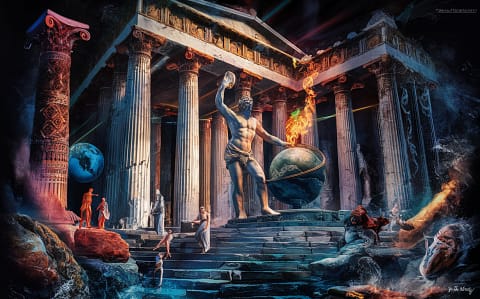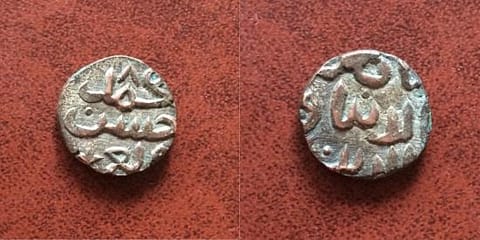Adam and Eve vs. Evolution: Contradiction or Harmony?
Since the dawn of existence, humanity has pondered its origins, creating countless stories and theories to solve this mystery. Religions explain the creation of humankind through narratives in sacred texts, while science approaches this question from a different perspective with the theory of evolution. These two distinct approaches are at the center of a centuries-long debate: Is there a contradiction between the creation of Adam and Eve and the theory of evolution, or can these two narratives be compatible with each other?
The story of Adam and Eve is one of the most fundamental narratives in Abrahamic religions regarding the origin of humanity. This story, found in the Quran, plays a significant role in understanding concepts such as human creation, sin, and responsibility. On the other hand, evolution, the widely accepted theory in the scientific world, argues that living species descended from a common ancestor and changed over time through mechanisms like natural selection. The differences between these two narratives are seen as a contradiction by some, while others believe that these two approaches can be compatible.
This article aims to examine the relationship between the story of Adam and Eve and the theory of evolution in depth. We will evaluate different interpretations of religious texts in the light of scientific data and explore possible contradictions and points of harmony. Our goal is to build bridges between these two different perspectives, find common ground, and develop a broader understanding of the issue. We believe that this discussion is of interest not only to scientific and religious circles but also to anyone who questions the origin and purpose of human existence.
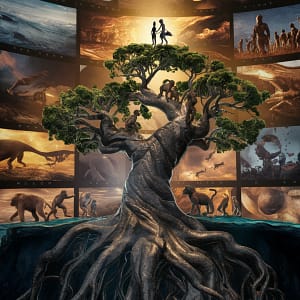
Theory of Evolution: The Story of Life's Transformation
The theory of evolution is a scientific explanation that suggests living species change gradually over time, descend from a common ancestor, and this change occurs through mechanisms such as natural selection, mutation, and genetic drift. This theory is one of the cornerstones of biological science and allows us to understand the diversity, complexity, and adaptability of life.
Basic Principles:
- Common Ancestor: It is thought that all living beings evolved from a common ancestor that lived billions of years ago. This explains the genetic, anatomical, and physiological similarities between living beings.
- Variability: Individuals within living populations exhibit genetic variations. These variations arise as a result of mutations (random changes in DNA) and genetic recombination (the mixing of genes during sexual reproduction).
- Natural Selection: Environmental conditions affect the survival and reproduction chances of living beings. Individuals with advantageous traits tend to leave more offspring. This causes advantageous traits to become widespread in the population, while disadvantageous traits decrease.
- Adaptation: Living beings adapt to their environment through the process of natural selection. This adaptation means that living beings develop traits that increase their chances of survival and reproduction.
- Speciation: Over time, genetic differences between populations can accumulate, and these differences can lead to the formation of new species.
Evidence of Evolution:
- Fossil Records: Fossils, the remains of living beings from millions of years ago, show how species have changed over time. Fossils allow us to document changes in the anatomical structures of living beings and the emergence of new species.
- Biogeography: The distribution of living beings in different geographical regions supports the theory of evolution. For example, the similarities between bird species on nearby islands show that these species evolved from a common ancestor.
- Comparative Anatomy: Similar organs and structures in different living species (e.g., the human arm, bird wing, whale fin) indicate that these species descended from a common ancestor. Such similarities are called "homologous organs".
- Moleküler Biyoloji: DNA ve proteinlerdeki benzerlikler, canlılar arasındaki evrimsel ilişkileri ortaya koyar. İnsan ve şempanze DNA’sının %98 oranında benzer olması, bu iki türün yakın bir zamanda ortak bir atadan ayrıldığını gösterir.
- Embryology: Similarities between the embryos of different living species reflect evolutionary relationships. For example, the presence of gill slits and a tail in human embryos indicates that humans evolved from fish-like ancestors.
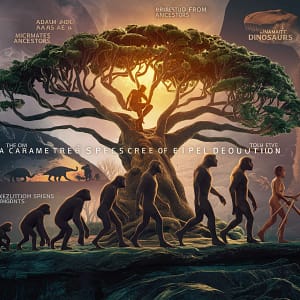
Acceptance in the Scientific Community:
The theory of evolution is overwhelmingly accepted by the scientific community. Numerous scientific studies and evidence support the theory of evolution. This theory has important applications not only in the field of biology but also in many different fields such as medicine, agriculture, and environmental science.
The theory of evolution is constantly being tested and developed through scientific methods. New findings and technologies allow us to better understand the process of evolution. However, the basic principles of the theory of evolution and the fact that living beings evolved from a common ancestor are indisputably accepted by the scientific community.
The Story of Adam and Eve: Beliefs and Interpretations
The story of Adam and Eve is a central narrative in Abrahamic religions about the origin of humanity. Verses in the Quran, such as Surah Al-Baqarah 22 and Surah Al-A'raf 189, state that Adam was created from clay and Eve was created from Adam. This story forms the basis for concepts such as the creation of man, original sin, expulsion from paradise, repentance, and forgiveness.
Adam and Eve in the Quran:
- Creation: It is stated that Adam was created from clay and Eve from Adam.
- Paradise and the Forbidden Fruit: Adam and Eve sin by eating the forbidden fruit while living in paradise.
- Punishment and Repentance: They are expelled from paradise because of their sins but repent and are forgiven by God.
- Ancestors of Humanity: Adam and Eve are considered the ancestors of all people on Earth.
Different Religious Interpretations:
The story of Adam and Eve is a text open to different religious interpretations. These interpretations focus on the symbolic or literal meanings of the story.
- Literal Interpretation: Some interpreters accept the story as a real historical event and believe that the narratives happened exactly as described. According to this interpretation, Adam and Eve are the biological ancestors of all humanity.
- Symbolic Interpretation: Some other interpreters approach the story symbolically. According to this interpretation, Adam and Eve are archetypal figures representing the common experiences of humanity. The forbidden fruit symbolizes human free will and the desire to attain knowledge, while the expulsion from paradise represents the transition to earthly life and facing challenges.
- Sufi Interpretation: In the Sufi tradition, the story of Adam and Eve is interpreted as an allegory of the human journey to discipline the ego and get closer to God. Adam represents the pure and divine essence of man, while Eve represents the ego.
Other Creation Narratives:
Besides the story of Adam and Eve, different cultures and mythologies have various narratives about the creation of humans. For example, in Greek mythology, Prometheus shapes humans from clay, while in Chinese mythology, Nüwa makes humans from mud. These narratives offer different perspectives on the origin of humans and reflect a universal curiosity.
The story of Adam and Eve raises important questions about the origin and purpose of human existence. Different religious interpretations of this story hold different meanings for believers. However, regardless of which interpretation of the story is adopted, this narrative about the creation of man remains a thought-provoking story that maintains its place in human history.
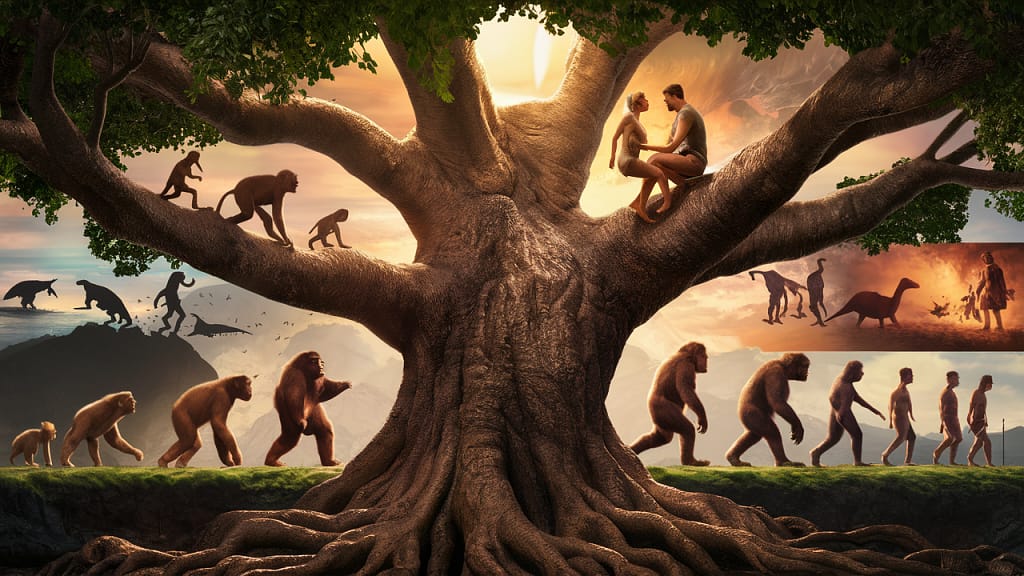
Science and Religion: Different Perspectives and Approaches
Science and religion are two of the most fundamental areas of knowledge and meaning-seeking in human history. Science seeks to understand the natural world through observation, experimentation, and reasoning, while religion focuses on issues of faith, values, morality, and spirituality. How these two fields interact has been interpreted in different ways throughout history, and various approaches have emerged.
Conflict Approach:
The conflict approach views science and religion as fundamentally opposed and irreconcilable. According to this view, the accuracy of scientific explanations is supported by evidence, while religious beliefs are dogmatic and unchanging. Therefore, scientific findings may contradict some statements in religious texts. For example, while the theory of evolution argues that living beings come from a common ancestor and change over time through natural selection, some religious texts state that humans were created directly. This situation, according to the conflict view, creates a conflict between science and religion.
Harmony Approach:
The harmony approach argues that science and religion answer different questions and therefore do not have to contradict each other. Science focuses on the question of "how?" while religion seeks answers to the questions of "why?" and "for what purpose?" According to this view, scientific explanations help us understand the workings of the natural world, while religious beliefs add meaning and purpose to our lives. For example, while the theory of evolution explains how living beings diversified and adapted, religious beliefs are concerned with the question of whether there is a divine will behind this process.
Within the harmony approach, there are also different interpretations. Some thinkers argue that some expressions in religious texts have metaphorical meanings and do not contradict scientific facts. For example, interpreting the story of Adam and Eve symbolically or thinking that the process of evolution is guided by God.
Independence Approach:
The independence approach views science and religion as two completely separate and independent domains. According to this view, there is no need for conflict between science and religion since they answer different questions. Science uses observation and experiment-based methods to understand the natural world, while religion is concerned with faith, values, and spirituality. Therefore, scientific explanations are not expected to influence religious beliefs, nor are religious beliefs expected to guide scientific research.
When evaluating the relationship between the story of Adam and Eve and the theory of evolution, it is important to consider these different approaches. Each approach has its own consistent arguments and supporting evidence. However, it is not possible to explain the relationship between science and religion with a single approach. This relationship can be interpreted in different ways depending on historical, cultural, and personal factors.
In conclusion, the relationship between science and religion is a complex and multifaceted issue. How these two fields interact can vary depending on people's worldviews, beliefs, and values. However, understanding different approaches and perspectives is important for maintaining a healthy dialogue between science and religion.
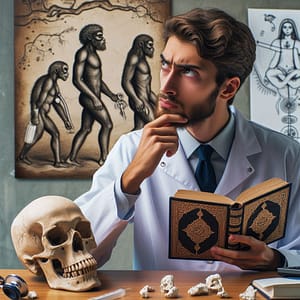
Claims of Contradiction: Areas of Tension Between the Theory of Evolution and the Story of Adam and Eve
Claims of incompatibility between the theory of evolution and the story of Adam and Eve often stem from approaches that adhere strictly to the literal interpretation of religious texts and disregard scientific findings. The fundamental areas of tension underlying these claims are shaped around the concepts of human origins, the process of creation, and the first human couple. However, each of these areas of tension can be addressed with different perspectives and interpretations, and potential solutions can be offered.
Human Origins
The theory of evolution argues that humans evolved from primate ancestors over millions of years through natural selection and genetic changes. This means that humans share a common biological history with other living beings. In contrast, religious texts state that humans were created from the earth. At this point, literal interpreters reject the theory of evolution by arguing that the earth is literally the raw material of humans. However, symbolic interpreters offer a perspective compatible with evolution by suggesting that the earth represents the earthly nature and material origin of humans. This interpretation emphasizes the fact that humans are biologically made of the earth, while not contradicting the evolutionary process. In addition, the theistic evolution approach seeks to combine the two narratives by accepting the process of evolution while arguing that this process takes place under the will and control of God. This approach aims to create a harmonious synthesis by incorporating scientific findings into faith.
The Process of Creation
The difference between the gradual and long-term process of change in the theory of evolution and the sudden and direct creation narrative in religious texts is also seen as an area of tension. Literal interpreters accept the statement that creation was completed in six days as literal time periods, while symbolic interpreters consider these days as a metaphorical expression representing the different stages in the formation of the universe and life. This interpretation allows for an understanding that creation took place over a long period of time and does not contradict the findings of the theory of evolution. In addition, some theologians state that the Hebrew word "yom", which is the equivalent of the word "day", can refer to an indefinite period of time, and therefore creation can be interpreted as having taken place over a long period of time. This interpretation shows that religious texts can be read in a way that is consistent with scientific findings.
The First Human Couple
The belief that Adam and Eve were the first human couple contradicts the theory of evolution, which posits that humans evolved from a population and there was no single first pair. Literal interpreters argue that Adam and Eve are the biological ancestors of all humans, while symbolic interpreters see these figures as archetypes representing the common experiences and moral development of humanity. This interpretation allows Adam and Eve to be understood as symbolic figures representing universal features of human nature rather than real people. In the theistic evolution approach, it is thought that Adam and Eve may have been chosen at a certain stage in the evolutionary process and endowed with a special spirit or consciousness by God. This interpretation accepts the biological evolution of man while emphasizing the spiritual dimension of man.
In addition to these areas of tension, the differences between the emphasis on randomness and purposelessness of evolutionary theory and the understanding of divine will and purpose of religious beliefs are also a matter of debate. However, these differences can be interpreted as evolution explaining natural processes, while religion leads to thinking about the meaning and purpose of these processes. Thus, an understanding that science and religion answer different questions and do not exclude each other can be adopted.
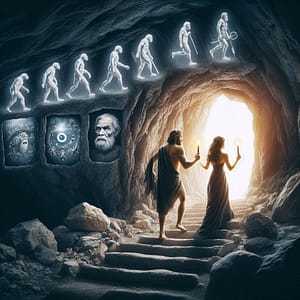
Alternative Interpretations: Bridges Between Evolution and the Story of Adam and Eve
When evaluating the relationship between the theory of evolution and the story of Adam and Eve, there are alternative approaches that offer different interpretations and points of reconciliation. These approaches aim to bridge the gap between two different perspectives by making scientific findings compatible with religious beliefs.
Theistic Evolution (Evolutionary Creation)
This approach accepts the theory of evolution, while arguing that the evolutionary process is guided and controlled by God. According to this interpretation, Adam and Eve may have been chosen by God at a certain stage in the evolutionary process and endowed with a special spirit or consciousness. This offers a perspective that explains both the biological and spiritual dimensions of man. Theistic evolution aims to provide a scientifically and religiously satisfying explanation by incorporating scientific findings into faith.
Symbolic Interpretation
This approach interprets the story of Adam and Eve not as a real historical event, but as a symbolic narrative representing the common experiences and moral development of humanity. According to this interpretation, Adam and Eve are archetypal figures representing man's free will, desire to attain knowledge, potential to sin, and ability to repent. This interpretation reveals the universal messages of the story and deep insights into human nature.
Spiritual Evolution
This approach argues that humans evolve not only biologically but also spiritually. According to this interpretation, Adam and Eve represent a turning point in the spiritual development of humanity. Their story tells the process of developing man's devotion to God, moral values, and spiritual awareness. This approach offers a holistic perspective that encompasses both scientific and religious teachings.
The Interpretation of Adam and Eve as Symbolic Ancestors
This approach interprets Adam and Eve not as the biological ancestors of all humanity, but as symbolic figures representing the beginning of a new era in a particular community or human history. According to this interpretation, the story of Adam and Eve symbolizes an important stage in human social, cultural and moral development.
Divine Intervention in the Evolutionary Process
This approach accepts the theory of evolution while arguing that God intervenes in the evolutionary process at certain points. For example, God may be thought to play a special role in critical stages such as the acquisition of consciousness or the development of moral values. This interpretation aims to add a broader meaning to the evolutionary process by combining scientific explanations with religious beliefs.
These alternative interpretations offer different ways of trying to reconcile the theory of evolution with the story of Adam and Eve. Each interpretation has its own strengths and weaknesses. However, the common point of these interpretations is that they try to make scientific findings compatible with religious beliefs, rather than ignoring them. In this way, it may be possible to develop an understanding that is satisfying both scientifically and religiously.
Conclusion: The Meeting Point of Science and Faith: A Call for Dialogue
In this article, where we examined the relationship between the story of Adam and Eve and the theory of evolution in depth, we revealed the richness and complexity of different perspectives. We have seen that these two different narratives about the origin of humanity, although seemingly contradictory at first glance, can actually coexist without excluding each other.
In the light of scientific data, we know that the theory of evolution strongly supports that living things come from a common ancestor and change gradually over a period of millions of years. This theory shows that man is also a part of this evolutionary process and shares a common biological history with other living things. However, this does not mean that we ignore the spiritual dimension of man, his moral values and his search for meaning.
The story of Adam and Eve, beyond being a religious narrative about the creation of man, is a rich source that symbolizes the universal characteristics of human nature, free will, the desire to attain knowledge, the potential to sin, and the ability to repent. This story is an important source that people turn to when seeking answers to existential questions.
When evaluating the relationship between these two narratives, it is important to adopt an approach based on dialogue and understanding rather than a dogmatic approach. Instead of denying scientific findings or ignoring religious beliefs, trying to harmonize these two different sources of information can enable us to reach a more comprehensive and rich understanding.
Approaches such as theistic evolution seek to build a bridge between science and religion by accepting the theory of evolution while maintaining belief in God's creative power and universal order. This approach offers a perspective that is both compatible with scientific facts and nourishes religious beliefs.
Symbolic interpretations, on the other hand, consider the story of Adam and Eve as an allegory representing the common experiences and moral development of humanity. By focusing on the universal messages of the story, this interpretation can enable people from different beliefs and cultures to find common ground.
In conclusion, the relationship between the story of Adam and Eve and the theory of evolution is a constantly debated and reinterpreted issue with no single right answer. However, this debate itself is a reflection of man's search for meaning and his effort to attain knowledge. Therefore, it would be a more constructive approach to consider this debate as an opportunity to understand and respect different perspectives rather than as an area of conflict.
This article aims to encourage readers to think more about this issue and develop their own interpretations by addressing the relationship between the story of Adam and Eve and the theory of evolution from different angles. Let's not forget that science and religion are important tools in man's search for meaning, and using these two tools together can enable us to reach a richer and deeper understanding.
References in the Article on Adam and Eve and Evolution:
Scientific Articles:
Nature
The world's leading multidisciplinary science journal. It has published many important articles on the theory of evolution.
Example article: "Initial sequence of the chimpanzee genome and comparison with the human genome" (2005) - This article provides important information about evolutionary relationships through comparison of the human and chimpanzee genomes. You can access other evolutionary theory articles in Nature magazine from here: https://www.nature.com/subjects/evolutionary-biology
Science
One of the world's most prestigious scientific journals. It has published many groundbreaking articles on evolutionary theory and human evolution.
Example article: “A draft sequence of the Neanderthal genome” (2010) – Bu makale, insanın evrimsel geçmişine ışık tutan Neandertal genomunun dizilimini sunar.Science dergisindeki diğer evrim teorisi makalelerine buradan ulaşabilirsiniz: https://www.sciencedaily.com/releases/2010/05/100506141549.htm
Human Evolution and Genetic Studies
Example source: "Sapiens: A Brief History of Humankind" (Yuval Noah Harari) - This book explains the evolutionary history of humans in an understandable language.
Other sources: Popular science magazines and websites such as National Geographic, Scientific American provide up-to-date information on human evolution and genetic studies.
Religious Texts
The Holy Quran
Surah Al-Baqarah 22: "It is He who created you from a single person, and made his mate of like nature, in order that he might dwell with her (in love). When they are united, she bears a light burdenand carries it about (unnoticed). When she grows heavy, they both pray to Allah their Lord, (saying), "If Thou givest us a goodly child, we vow we shall (ever) be grateful."
Surah Al-A'raf 189: "It is He Who created you from a single person, and carries it about (unnoticed). When she grows heavy, they both pray to Allah their Lord, (saying), "If Thou givest us a goodly child, we vow we shall (ever) be grateful."
Torah (Genesis)
Genesis 1:27: "So God created mankind in his own image, in the image of God he created them; male and female he created them."
Works of Different Religious Commentators
Example: The Quran commentaries of exegetes such as Elmalılı Hamdi Yazır, Seyyid Kutub, Mevdudi, Ibn Kesir.
Philosophy and Philosophy of Religion Books
Ian Barbour, "When Science Meets Religion": An important work that addresses the relationship between science and religion with different approaches.
John Polkinghorne, "Science and Theology": A book that argues that science and religion are two different sources of knowledge that complement each other.
Alister McGrath, "Science & Religion: A New Introduction": A resource that summarizes current debates about the relationship between science and religion.
These sources will help you better understand the relationship between the story of Adam and Eve and the theory of evolution. To learn more about this topic, you can review these resources and evaluate different perspectives.
